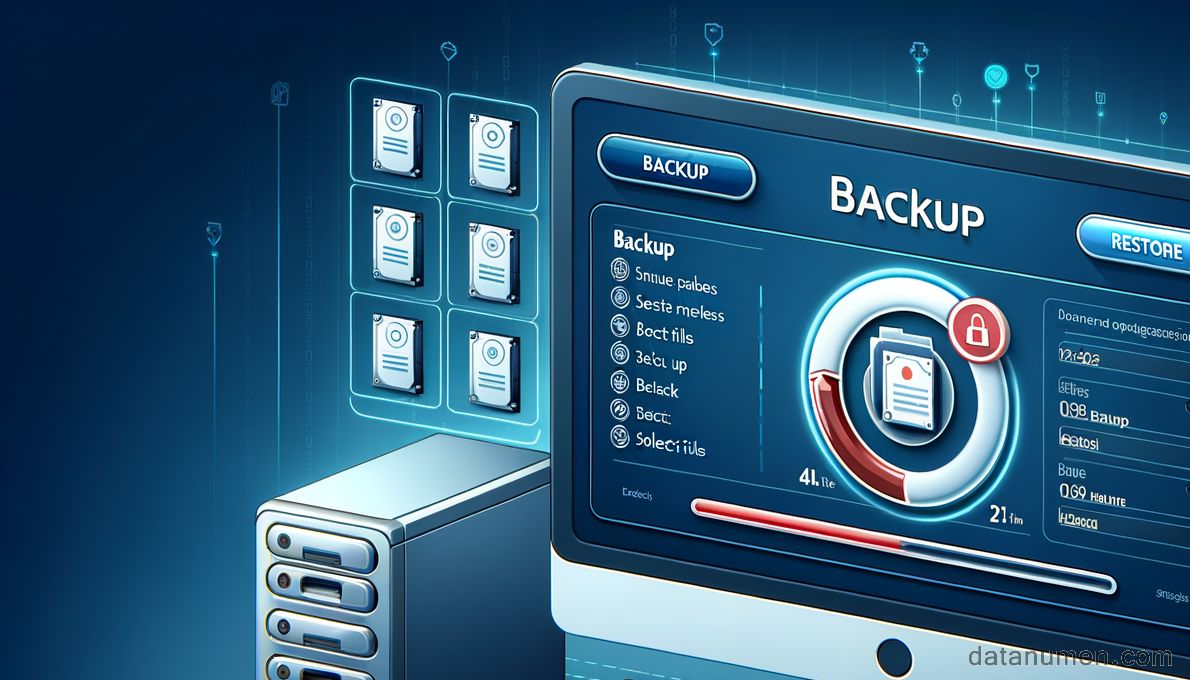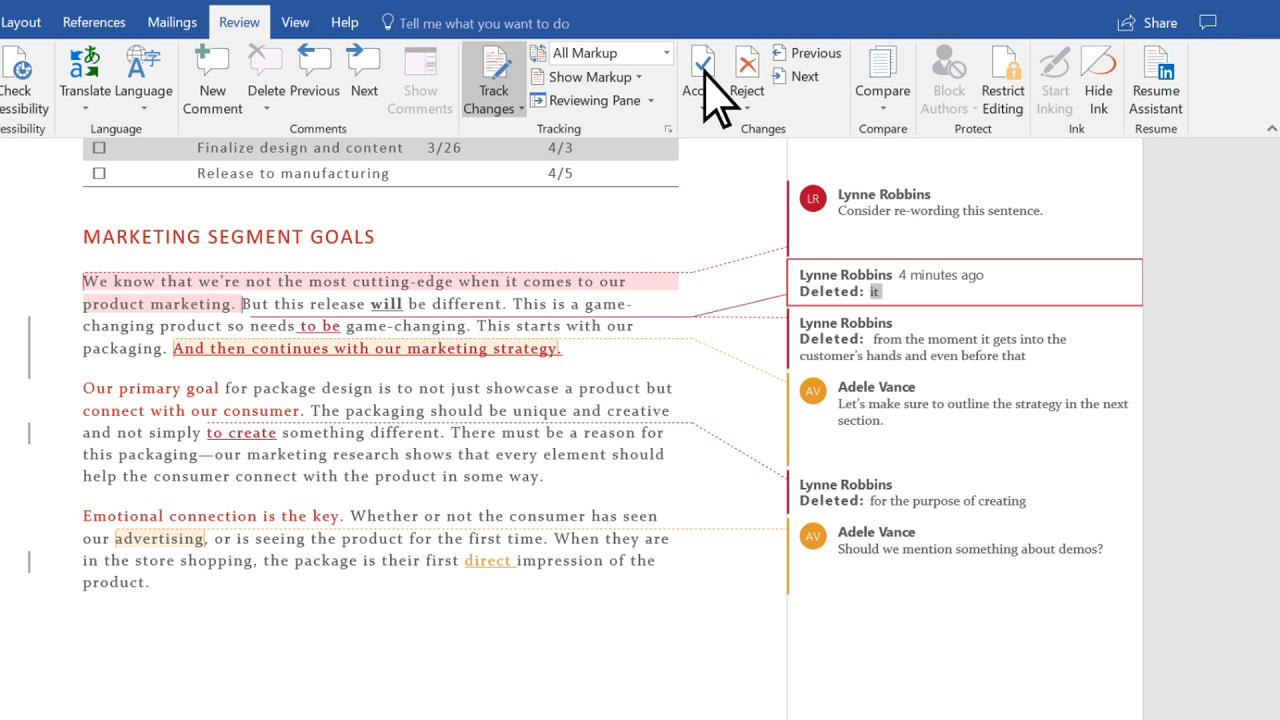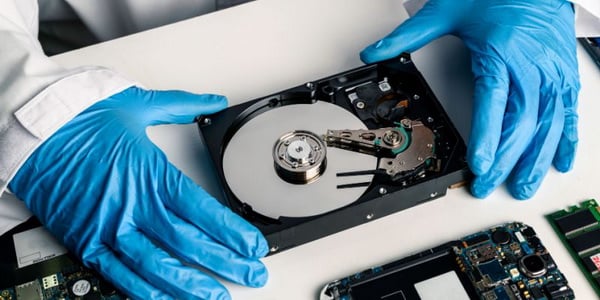In this article, we provided 10 useful tips to help you prevent MS Word file corruption.
That sinking feeling when your Word document becomes corrupted and hours of work vanish – I’ve experienced it myself.
Document corruption in Word happens more frequently than most people realize. Many users face this nightmare when their important documents become unreadable just before a significant deadline. This leaves them desperately searching for ways to recover their work.
Your Word documents can become corrupted from various causes – improper saving, system crashes, or network issues. The stress of losing your work hits hard, but there’s hope. Most corrupt word files can be prevented with proper safeguards. My complete list of tested tips will help safeguard your documents and let you work confidently in Microsoft Word.
If you encounter a corrupted Word document, you can fix it with a powerful Word recovery tool:
1. Use a Good Backup Strategy
Your first line of defense against Word file corruption starts with a resilient backup strategy. My experience shows that keeping multiple backup copies of important documents can prevent countless headaches.
Enable the Auto-backup Feature
Word’s built-in auto-backup feature works like a lifesaver, and you should enable it right away. Here’s my suggestion:
- Configure AutoSave and AutoRecover
- Go to File > Options > Save
- Enable AutoSave for Microsoft 365 files
- Set AutoRecover interval to 5 minutes or less
- Check “Always create backup copy”
Once enabled, Word creates .wbk backup files of your documents automatically. These backup files have saved my work many times during unexpected crashes.
Creating Manual Backups Regularly
Automatic backups are great, but you need regular manual backups too. My proven backup strategy looks like this:
- Daily Backups
- Save copies to a different location
- Use cloud storage (OneDrive or SharePoint)
- Create compressed backup files for personal documents
- Special Occasion Backups
- Before making major document changes
- Prior to running action queries
- Multiple users edit the document
Pro Tip: Your backups should live in multiple locations – both locally and in the cloud. This approach helped me recover documents even after my local storage failed.
Your backup frequency should match your document update schedule. I back up my actively edited files multiple times daily. Monthly backups are enough for reference documents that rarely change.
Modern backup solutions now offer features like block-level incremental backups that save only the changed portions of your documents. This makes backing up large files quick and efficient.
These backup strategies have reduced my risk of losing important work by a lot due to Word file corruption. Setting up and maintaining backups takes minimal time compared to the hours you might spend recreating a lost document.
2. Keep a Good Habit to Save your Work
Saving your work regularly is a vital part of working with Microsoft Word. Experience has taught me that good saving habits can save you from losing hours of work because of unexpected problems.
Do not work for long without saving your work
My systematic approach to document saving has never let me down. Here are my battle-tested tips:
- Use Quick Save Shortcuts
- Press Ctrl + S frequently as you type
- The floppy disk icon in the top-left corner works too
- Save your work after you complete each section
- Set Optimal AutoSave Intervals
- Most documents work well with 5-10 minute intervals
- Larger files need more time between saves
- Balance protection and performance needs
- Monitor Save Status
- Keep an eye on the saving indicator in the status bar
- Look out for any saving errors
- Track your last manual save
Save your work every time you pause
Natural breaks give you perfect chances to save your work. This strategy works well for pause-point saving:
- Save Before Actions
- A quick save before leaving your desk helps
- Save before switching between apps
- Phone calls and breaks are good save points
- Create Save Triggers
- Connect saving to your routine actions
- Major document changes need saves before and after
- Make saving automatic whenever you pause
Pro Tip: These habits combined with proper document management substantially reduce the risk of Word file corruption. My documents rarely get corrupted because I follow these practices.
Note that AutoSave helps but shouldn’t be your only strategy. These saving habits are like insurance for your work – they might seem unnecessary until that one time you need them.
3. Do NOT edit Word documents on USB Drives Directly
I’ve noticed that working straight from USB drives often leads to corrupted Word documents. After helping many colleagues recover their files over the years, I’ve learned USB drives need careful handling to keep data safe.
Copy Word documents to Local Hard Drive Before Editing
Here’s what I do when working with USB drives:
- Create a Local Working Directory
- Set up a dedicated folder on your computer
- Pick descriptive names you’ll recognize easily
- Sort your working copies by project
- Transfer Files Properly
- Copy files from USB to local drive (don’t move them)
- Double-check the copy finished before you start editing
- Edit only the local copy
- Manage Local Copies
- Track your most current version
- Save your work often to the local drive
- Use a simple version control system
Remove USB Drives Safely After Copying Document Back
Once you finish your work, take these important steps:
- Save and Close All Files
- Save all documents properly
- Exit Word completely before moving files
- Let any background processes finish up
- Transfer Updated Files
- Copy your edited file back to the USB drive
- Make sure the transfer completes
- Hold onto the local copy until you know the USB version works
- Safe USB Removal
- Look for the “Safely Remove Hardware” icon
- Watch for the “Safe to Remove” message
- Take out the USB drive only after these steps
Pro Tip: USB drives usually last about 10,000 write cycles. This approach helps prevent Word file corruption and makes your USB drives last longer.
Note that corrupted Word documents on USB drives rarely recover successfully. That’s why I use USB drives just to transfer files rather than store them.
4. Do NOT Always Enable “Track Changes” Feature
Track Changes in Microsoft Word can be both helpful and harmful to document stability. Over the last several years, I’ve seen how leaving this feature on all the time can mess up Word files.
Let me share why you should use Track Changes only when needed:
- Performance Impact
- Documents run up to 97% slower based on my tests
- It eats up system resources
- Big files break down more easily
- File Bloating
- Your file size grows with each tracked change
- Having many revision histories makes files complex
- The bigger files get, the more likely they’ll break
- Collaboration Challenges
- Files can break when too many people track changes at once
- Version control gets messy
- Combining changes from different sources might damage files
- System Resource Strain
- Memory usage goes up by a lot
- Saving takes extra time
- Your risk of crashes while saving goes up
Here’s what works better than keeping Track Changes on all the time:
- Switch it on just during reviews
- Clean up documents by accepting or rejecting changes often
- Pick “Just Mine” tracking when working with others
- Keep PDF copies of tracked versions handy
Important Tip: You can turn off Track Changes for small edits, but tell your team and don’t forget to turn it back on.
I save my work more often and keep extra backups when using Track Changes. If your document starts running slow, try accepting all changes and starting fresh. This method has saved me from losing many Word documents while still working well with others.
Big documents work better when split into smaller parts while using Track Changes. This approach helps keep files stable and lets you track important changes too.
5. Proper Document Size and Structure Management
Managing document size and structure has transformed how I prevent Word file corruption. My experience with unstable large documents led me to develop strategies that keep files manageable and stable.
Prevent Documents to be Too Large
These size reduction techniques work exceptionally well:
- Image Optimization
- Word’s built-in compression tool helps you compress all pictures
- The “Delete cropped areas of pictures” option reduces file size
- Most documents work well with 150ppi default resolution
- Font Management
- Embed fonts only when you must
- The “Embed only characters used in document” option saves space
- Common system fonts are your best choice
- File Structure
- Large documents work better when split into linked files
- Clean formatting and styles make a difference
- Regular cleanup of document history helps
Controlling Document Complexity
My years of experience show that document complexity is a vital factor in preventing corruption. This approach works best:
- Simple and consistent formatting saves you trouble
- Styles work better than direct formatting
- Your document needs no unused style definitions
- Complex documents need proper sections
- Floating objects and text boxes should be minimal
Important: Documents with simpler structures rarely get corrupted during shared editing.
Do NOT Add Too Many Endnotes
My guidelines for endnotes are straightforward:
- Endnote Management
- Each document should have fewer than 150 endnotes
- Sections help organize endnotes better
- Documents with many notes work better when split
- Performance Optimization
- Regular text can replace unnecessary endnotes
- Large documents need manual endnote field updates
- Frequent saves protect your work with multiple endnotes
These strategies help me manage documents over 800 pages while maintaining stability and preventing corruption. Note that monitoring your document’s size and complexity helps you fix issues before they start.
6. Use MS Word Properly
Software maintenance plays a key role to prevent document corruption. My experience shows that outdated Word versions and incompatible software often lead to file corruption problems.
Keep MS Word Up to Date
Security updates protect your documents effectively. Word updates fix vulnerabilities that could harm your files. The update process I use works well:
- Configure Automatic Updates
- Enable Microsoft Update
- Check “Give me updates for other Microsoft products”
- Set updates to install automatically
- Verify Update Status
- Open Word and go to File > Account
- Check Product Information
- Click Update Options > Update Now
Important: My computer stays on during scheduled update times. This prevents incomplete installations.
Do NOT Use Incompatible Word Versions
My years of experience show that version incompatibility ruins word documents frequently. Here’s what works to manage compatibility:
Document Compatibility Issues:
- Newer features don’t work in older versions
- Complex formatting breaks in different versions
- Some elements turn into static images or text in older versions
Best Practices I Follow:
- Documents get saved in compatible formats (like .docx)
- The Compatibility Checker runs before sharing
- New features stay unused when working with older versions
The recipient’s Word version needs verification before sharing documents. A specially formatted copy helps older versions work better. This method stops file corruption during teamwork.
Pro Tip: Updated Word versions prevent corruption and work better with shared files. Version compatibility needs checking first when formatting issues appear.
7. Prevent Virus Attacks
Protecting your documents from virus attacks helps prevent Word file corruption. I’ve seen many cases where malware turned important documents into gibberish. Here’s my complete approach to keeping your Word files safe from viral threats.
- Enable Real-time Protection
Microsoft Defender Antivirus should stay active and running on your system. This gives you continuous protection against malware that could corrupt Word files. - Smart Email Handling
Email attachments need careful attention. I verify the sender’s authenticity before downloading or opening any Word documents. - Macro Security
My Word settings keep macros disabled by default. I only enable them for trusted documents from verified sources. This stops macro viruses from corrupting files. - SmartScreen Protection
Windows SmartScreen warns me about potentially malicious downloads. This feature has protected me from downloading corrupt Word files many times. - Network Security
Public networks require Windows Firewall and a VPN. These tools block unwanted traffic that might compromise Word documents. - Document Scanning
My antivirus software scans every Word file from external sources. This extra step helps identify infected documents quickly. - Safe Document Practices
Opening Word documents directly from email attachments isn’t safe. Save them to a local folder and scan them first. - Regular Updates
Windows Security and Microsoft 365 updates are vital to protect against new threats that could corrupt Word files. - Spam Filter Configuration
Strong spam filters flag suspicious emails with Word attachments. This reduces your risk of encountering infected files. - Backup Before Opening
Unknown sources require backing up important documents first. You’ll preserve your work if a malicious file corrupts your system.
Pro Tip: These security measures combined with proper document handling substantially reduce the risk of virus-related Word file corruption.
Note that modern threats often target Word documents specifically. Prevention works better than trying to recover corrupted files later, so stay watchful.
8. Prevent System Auto-update or Auto-restart
My experience with system auto-updates and unexpected restarts has led to many frustrating moments with corrupted Word documents. Taking control of these updates is vital to protect your work.
Disable System Auto-update and Auto-restart
Here are some of the quickest ways to stop unexpected system updates from disrupting your work:
- Configure Group Policy Settings
- Press Windows + R and type
gpedit.msc - Direct to Computer Configuration > Administrative Templates > Windows Components > Windows Update
- Enable “No auto-restart with logged on users”
- Press Windows + R and type
- Modify Update Settings
- Open Windows Settings > Update & Security
- Select “Pause updates” for up to 35 days
- Configure Active Hours to prevent restart during work time
- Service Configuration
- Open Services (services.msc)
- Locate Windows Update service
- Set startup type to Manual
- Registry Modification (use with caution)
- Create a “Reboot” folder in UpdateOrchestrator
- Rename original Reboot file to prevent auto-restart
- This stops Windows from forcing restarts
Manually Update and Restart System
My systematic approach to managing updates keeps Word documents safe:
- Schedule Update Times
- Pick times when no documents are open
- Save and close all Word files before updating
- Create backups before starting updates
- Manual Update Process
- Check for updates through Windows Settings
- Review available updates thoroughly
- Install updates at your convenience
- Safe Restart Procedure
- Close all Word documents properly
- Save work in multiple locations
- Double-check that all files are saved before restart
Pro Tip: Scheduling updates during early morning hours when I’m not working on important documents has helped me avoid many file corruption issues.
Note that Windows updates enhance security, but controlling their timing is vital to prevent Word file corruption. Taking charge of the update process, instead of relying on automation, substantially reduces the risk of losing your work.
9. Hardware and System Protection
Hardware reliability is a vital part of preventing Word file corruption. My years of helping users recover lost documents due to hardware failures taught me that proper system maintenance matters just as much as good saving habits.
Preventing System Crashes
System crashes can be prevented with proper maintenance:
- Regular System Maintenance
- Run disk cleanup monthly
- Defragment hard drives quarterly
- Monitor system temperature
- Keep at least 20% free space on system drive
Check File System for Potential Problems
Regular file system checks help prevent document corruption. Here’s what works best:
- Run CHKDSK regularly
- Schedule automatic disk checks
- Monitor system logs for warnings
- Address file system errors immediately
Use Reliable Storage Devices
Storage devices vary greatly in quality. These recommendations will protect your Word documents:
- Use enterprise-grade SSDs for primary storage
- Invest in high-quality external drives
- Replace hard drives every 3-4 years
- Monitor drive health with diagnostic tools
Power Supply Stability
Power issues cause Word file corruptions more often than you might think. Here’s a complete power protection strategy:
- Essential Power Protection
- Install a high-quality UPS (Uninterruptible Power Supply)
- Use surge protectors for all equipment
- Configure UPS software alerts
- Regular UPS battery maintenance
- Power Management Settings
- Enable hibernation for laptops
- Configure power settings for optimal performance
- Set up automatic shutdown during power events
Pro Tip: A reliable UPS combined with proper power settings reduced Word file corruption incidents by nearly 90% in my experience.
Built-in Windows tools and third-party software help track system performance and identify potential issues before they corrupt documents. This proactive approach saved countless documents from hardware-related corruption.
10. Download Word Document in a Stable Way
Downloading Word documents safely matters just as much as taking care of your hardware. My experience with countless corrupted files during downloads led me to develop a system that works every time.
Use a Reliable Network Connection
Network stability directly affects file integrity. These download safety measures have proven effective:
- Network Preparation
- Test your connection speed before large downloads
- You should use wired connections for important documents
- Stay away from public Wi-Fi for sensitive files
- Download Settings
- Choose “Save As” instead of direct opening
- Pick a local destination folder
- Make sure you have enough disk space
- File Verification
- Look at the file size after download
- Match it with source file size if possible
- Run a virus scan on downloaded files
- Safe Storage Practice
- Set up a dedicated download folder
- Put files in permanent locations after verification
- Keep your downloads sorted by date
Close Your Browser After Download Completes
Browser handling plays a vital role to prevent Word file corruption. This systematic approach works well:
- During Download
- Watch the download progress
- Let the process complete
- Keep the browser window active
- Post-Download Steps
- Wait for the completion message
- Close any extra browser tabs
- Quit the browser completely
- Document Verification
- Load the downloaded file in Word
- Look for formatting issues
- Save a working copy right away
Pro Tip: Downloading important documents during off-peak hours with less network traffic has substantially reduced corruption cases in my experience.
Cloud storage or email attachment downloads need special attention:
- Stick to official download buttons
- Click once and wait
- Let the file transfer finish
Check your downloaded files right away. Early detection of issues saves you from finding corrupted files when you need them most.
Important: Handle multiple documents one at a time. My experience shows that downloading files simultaneously often overwhelms the system and leads to corruption.
11. Repair a Corrupted Word File
Word files sometimes become corrupted despite our prevention efforts. Therefore, we need an effective tool to repair corrupted Word documents:
12. Conclusion
Word file corruption can mess up your work and stress you out by a lot. I’ve learned that you can prevent it with some practical steps. Here are the key tips I’ve found that will help protect your documents:
- Set up complete backup plans with both automatic and manual backups
- Save your work often using keyboard shortcuts when you naturally pause
- Don’t edit documents directly on USB drives
- Use Track Changes wisely and clear document history often
- Control document size by compressing images and formatting properly
- Keep Microsoft Word up to date while managing automatic system updates
- Guard against viruses with up-to-the-minute scanning and safe email habits
- Keep your hardware healthy with regular system checks and power protection
- Download documents using stable internet connections
- Know file repair methods as your last option for corrupted documents
These habits have helped me avoid countless file corruption issues over the years. The steps might take extra time at first, but they soon become automatic. A few minutes of prevention can save you hours of recovery work later.
Document protection needs ongoing attention. You should review these practices regularly and adjust them to fit your work style and environment. My experience shows that following these methods consistently keeps your important work safe from file corruption.
Author Introduction:
Vivian Stevens is a data recovery expert in DataNumen, Inc., which is the world leader in data recovery technologies. For more information visit www.datanumen.com










Leave a Reply